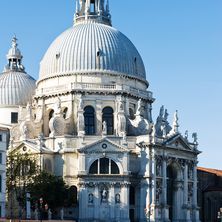

The Church of St Mary of Health, commonly known just as the Salute, is the most original church in Venice, in terms of its design. Its world-renowned dome, which appears on every other Venetian postcard, has become the central point of reference in the city's skyline. Whether you approach the St Mark's bay from the Grand Canal or from the Giudecca Canal, or even from the Lido, the dome is the first architectural wonder that your eyes will fall on.
In 1630 Venice was ravaged by a brutal plague, killing roughly 80,000 people, which at the time was about half of the city's population. The final toll, which included people living in other parts of the Republic, was over 600,000. After the epidemic began to die down, the city decided to dedicate a shrine in honor of the Virgin, or better, Our Lady of Health. There had already been churches dedicated to protectors from the plague such as St Roch and St Sebastian; there was even a church dedicated to Christ the Redeemer, built by Palladio at the end of the late 16th century plague. But unfortunately praying in those shrines did not help the Venetians and therefore they decided to erect a new place of worship, this time dedicated not to God but to the mother of God. The authorities issued a competition, which was won by Baldassarre Longhena, who became the leading Venetian architect in the 17th century. He wrote: 'I have created a church in the form of a rotunda, a work of new invention, not built in Venice, a work very worthy and desired by many. This church, having the mystery of its dedication, being dedicated to the Blessed Virgin, made me think, with what little talent God has bestowed upon me of building the church in the shape of a crown.' The Salute would become Longhena's most significant work and the city's last plague church.
Construction began in 1631 and went on until 1687, a year before the architect's death. However, before laying the foundation, the Senate had to settle a little dispute with the Venetian Patriarch who owned the church and seminary that had to be taken down in order to build the Salute. This particular location had been selected because of its easy access from St Mark's Square. In fact, ever since the beginning of the church's construction, every November 21 the city celebrates the Feast of the Presentation of St Mary of Health by laying a pontoon bridge over the Grand Canal and attending mass in the church.
The Salute is not only strikingly beautiful, it is a massive work. It stands practically on the tip of Dorsoduro, a part of the city that was not the sturdiest one back in the 17th century. Depending on the historical document, anywhere from one hundred thousand to one million pales had to be driven into the seabed in order to create the foundation. The structure is octagonal with one large dome, one smaller one and two belfries at the rear. Istrian stone and marmorino, a type of plaster, were used for the exterior. The main facade shelters statues of the Four Evangelists and on the main dome stands the statue of the Virgin.
Inside, we find a spacious, luminous circular nave with arches leading to high, cavernous chapels. The three altars to the right as we enter are decorated with paintings depicting various episodes from the life of the Virgin: the Presentation of Our Lady in the Temple, the Assumption of Our Lady, and the Nativity of Our Lady. The altarpiece for the third altar on the left is a work of Titian's, the Descent of the Holy Ghost.
The high altar was designed by Longhena himself. It contains a Byzantine icon of the Madonna and Child from the 12th century called 'Madonna the mediator.' It was brought to Venice from Crete, which at the time was Venetian territory, after the island was conquered by the Ottomans in 1669. The altar's statues representing the Virgin expelling the plague were created by Flemish sculptor, Josse de Corte.
The Salute's sacristy also houses several masterpieces. There we find Tintoretto's Marriage at Cana and self-portrait. There we can also admire Titian's St Mark Enthroned with Saints Cosmas, Damian, Sebastian and Roch, which is the sacristy altarpiece, as well as the ceiling paintings of David and Goliath, Abraham and Isaac and Cain and Abel. Titian's display does not end there: the Doctors of the Church on the eight circular paintings called tondi and the Evangelists are also fruits of the 16th century master.
There has not been a painter - Venetian or foreign - who did not capture the Salute on his canvas. We find the church in the works of all the 18th century Venetian landscape painters, who are better known as the Vedutisti. Foreigners such as John Singer Sargent and Joseph Turner also gloried the church with their brush, and perhaps in a more unique manner: they were more concerned with they way the dome appeared in the constant changes of light. Ever since its construction, the dome has been the beacon of the St Mark's Bay, serving as a focal point for artists lost in the inundating beauty of the city.